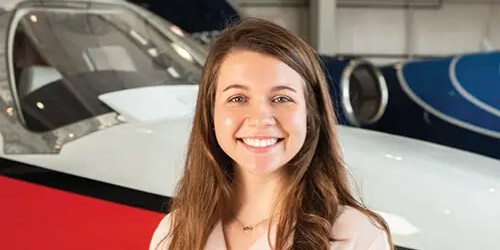Click Here to View This Page on Production Frontend
Click Here to Export Node Content
Click Here to View Printer-Friendly Version (Raw Backend)
Note: front-end display has links to styled print versions.
Content Node ID: 412917
As NBAA rolled out its Sustainable Flight Department Accreditation program, the organization strived to take a holistic approach toward sustainability. Electric, sustainable aviation fuel (SAF), and more efficient flight operations and aircraft are widely viewed as central steps for a greener path. But industry leaders also readily agree that they are among numerous steps that companies can take toward a more sustainable future and that all organizations can take some of these actions.
In fact, NBAA’s inaugural class of the audit-based program reflects that with registrations in areas of ground support, infrastructure, and operations, along with flight. Aviation entities are organizing their efforts, aligning with parent organizations, and learning what their companies already have that they can take advantage of in their quest for sustainability, said Stewart D’Leon, NBAA director of environmental and technical operations for NBAA.
“We've been delightfully surprised with some of the strategies, what they're putting together, and what they're doing and the goals they've set,” D’Leon said of the accreditation applicants.
Flight departments that have approached their parent organizations on accreditation have found this is being well received because their company leaders are also looking at their carbon footprints. “Their leadership is saying, ‘that's really great because we were trying to figure out how to connect with the various divisions,’” D’Leon said, adding this is exactly what NBAA hoped could be a result of the accreditation program—facilitating “real” connections. “And, I'm delighted to say that a few of the flight departments have become the golden children of the organization because they're leading the charge.”
Emily Tobler, manager of accreditation and environmental at NBAA, agreed. “We’ve got some folks who are now leading the charge for their organizations, but I think there's also just been a lot of mutual discovery [that] each other exists and [they] can help each other accomplish the same goals.”

The program has “put a lens” on those conversations and about other elements of sustainability, Tobler said. “Talking about propulsion systems and specifically our carbon impact from jet fuel is top of mind for everyone. But there's a lot of other conversations that are going on here about waste management and about energy,” she said.
For example, Tobler noted flight departments have had conversations about never seeing a utility bill in the time they’ve owned or leased hangars but believing they can help resource renewable energy. Now they are developing relationships with their utility providers.
“We’re all learning as an industry,” D’Leon furthered.
NBAA’s accreditation program is just one of numerous programs available on the sustainability front. The National Air Transportation Association has a Sustainability Standard for Aviation Businesses program, and the European Business Aviation Association developed a Standards & Training for Aviation Responsibility and Sustainability (STARS) initiative that’s modeled after an Airports Council International initiative, among others.

Whether through accreditation, another industry program, parent company collaboration, or forging an individual path, Scott Cutshall, Clay Lacy Aviation's senior v-p of development and sustainability, advises that organizations should “just start.”
Cutshall has provided numerous presentations, including at AIN’s own Building A Sustainable Flight Department regional forums held in 2021 and 2022, on how industry organizations can move forward. The first thing he tells people is to think broader than the environment and think about what’s doable.
“When someone says sustainability, most people in their mind immediately go to environmental. But there's also the social aspect and the economic aspect of sustainability. You can take a bunch of actions to be very environmentally friendly, but if that causes economic harm to the company, eventually the company won't be around to be environmentally friendly,” Cutshall said.
He noted the many questions he receives on cost and said, “if it costs too much, then just don't take that action. But what about the seven other actions that don't cost anything? I think the first thing I tell people is you have to take a holistic view and there are 5,000 things I can do to be environmentally friendly and more sustainable."
The industry is not asking organizations to jump into all sustainable means immediately, but rather “just start. If every company just started taking action on operating more sustainably, then the collective impact would be enormous.”
To begin with, companies can determine what their Scope 1 and Scope 2 emissions are.
“It’s kind of like when you decide to exercise,” he explained. “If a person wants to lose 10 pounds they have to get on the scale to see where they are and whether they will achieve their goal down the road. By stepping on the scale—[to determine] your Scope 1 and Scope 2 emissions—then you know where you are and then you can start to make plans to reduce them.”
Cutshall noted that a lot of resources are available to help accomplish that task. “If somebody was to Google how to measure my carbon footprint, there's a lot of resources out there.” In addition, NBAA has been developing management resources to help walk organizations through such efforts.
Generally speaking, Scope 1 involves direct emissions derived from an organization’s own facilities and vehicles or controlled sources. This could be fuel burned from ground surface equipment, heating oil used in facilities, or even an FBO’s courtesy vehicles, Cutshall explained.
Scope 2 is indirect emissions from purchased energy, such as electricity. Beyond that is Scope 3, which is less in control of an organization but represents emissions that occur in a company’s value chain both upstream and downstream.
Once an organization can determine its footprint—Cutshall said to focus on Scope 1 and 2 because 3 is not in direct control of the company—“the first thing that everybody can do is offset those emissions. They can buy carbon offsets to offset those emissions.”
That makes a company carbon-neutral from the beginning. However, he stressed the offsets are not the end solution. “It's intended to be a bridge,” because the company has not yet reduced its emissions.
Step two is looking at how to reduce emissions. “Ideally we would eliminate our emissions completely,” Cutshall said, but acknowledged that is a long-term goal. In the interim, organizations should ask what options are widely available or that can be implemented more immediately.
“If I'm looking to reduce my electricity, can I put motion sensors so that if somebody leaves a room and forgets to turn off the light, it goes off automatically? Can I change light bulbs to LEDs because we know LEDs burn less electricity than incandescent bulbs or fluorescent bulbs,” he suggested.
Cutshall added that FBOs may not be able to reduce ground vehicle use, but may be able to look at renewal diesel, which is “a drop-in fuel. You don't have to change your trucks, you don't have to do anything. You're just buying a different product.” Further, he continued, “If you have courtesy vehicles, can you replace one with an electric vehicle? [Can you] get rid of single-use plastics with things that are compostable and recyclable?”
The bottom line, Cutshall said, “There are lots of ways to reduce your emissions. And the goal is once you know what your emissions are, you've taken actions to reduce your emissions, then you offset what's left over and then you start the process over again.”
The idea is to decrease emissions over time so the amount that is offset gets smaller and smaller every year. “The holy grail is I don't have to buy offsets anymore.”
Clay Lacy began taking this approach in 2019, putting together a three-year plan on steps it would take to reduce its emissions.
True to his advice, Cutshall said its efforts have not been a “huge financial burden on the company.” Most of the costs have surrounded the time and energy focused on transitioning to greener options. As an example, Clay Lacy has switched a couple of locations from diesel to renewable diesel. The costs were the same. “There was zero financial impact to the company, but it significantly reduced our emissions,” he said.
It also has transitioned some ground service equipment to electric, activated a 500kw solar array at its headquarters, sourced renewable resources for its electricity at its John Wayne Airport facility in California, offered carbon offsets for its management clients, sold SAF to clients, conducted a waste recycling program, and changed from plastic water bottles to boxed water, among other efforts. It was certified as a member of the Environmental Protection Agency’s Green Power Partnership and it gets the claim to be the first recognized under NATA’s Sustainability Standard for Aviation Businesses program.
Cutshall said the benefits of these efforts have been tangible. The company has lowered its emissions by 35 percent. As importantly, the aviation business chain is seeing a culture shift. “More and more people throughout the company are wanting to contribute to the company's actions. And I think that's a great thing to see the buy-in from people,” he said, adding they are pitching in on new ideas to help the efforts.
Another significant benefit has been recruiting. “When we ask candidates that are in the interview process, ‘what attracted you to Clay Lacy,’ we're starting to hear, ‘I saw that you have a sustainability program.’ So, from a recruiting standpoint, it's something that job seekers are starting to pay attention to.”
Jo Damato, senior v-p of education, training, and workforce development for NBAA, agreed that sustainability initiatives are bringing benefits in workforce development. “We're definitely seeing this conversation connecting the generations and actually showing that we are looking to our new entrants into the field to help us and to educate us because they've been exposed to this at a much earlier time than we have. Within the industry, it seems to be one of the main conversation starters.”
If the industry is going to attract new people, then it must consider value alignment, Damato continued. “A lot of our young people really know…what are my values and how am I willing to spend my 40 hours a week plus with an organization to know that that is amplifying my values versus crushing them. I think they're looking at that.” Those looking at a career in business aviation want to reconcile their passion for environmental concerns and sustainability. “They're figuring out how to marry those things and they're getting excited about it,” she said.

NBAA's D’Leon added: “We're all on an even playing field. So whether you've been in this industry for 40 years or you're just stepping into this industry, we're all really learning and coming up at the same time, which gives us the opportunity to come to the table from a variety of generations within our career fields and all have a seat at the table and be leaders in this space."
Along those lines, Cutshall provided another piece of advice. “You don't have to do it alone. There's a lot of resources.” Pointing to the NBAA program, he said, “even if you decide not to go through the accreditation, [the association] published the complete blueprint of how to start acting more sustainably. NATA has a sustainability audit checklist that you can go download from their website for free.”
Cutshall pointed out that business aviation is a community. “Call other people in the industry and ask, what are you doing?” But bring others to the table both within and outside the organization, he said.